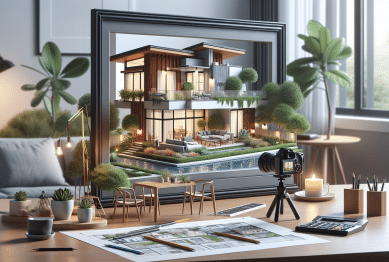Enhancing your rental property can turn it into a prime choice for quality tenants. This guide explores renovation trends, affordable upgrades, and insights for landlords striving for steady occupancy and better returns. Learn which upgrades deliver value while supporting compliance, comfort, and appeal.
Understanding Modern Tenant Expectations in Rentals
Today’s rental property market is notably competitive. Tenants are researching their options and expect more from rental housing than ever before. Whether aiming for families, young professionals, or retirees, owners who address these preferences often achieve higher rental yields and longer tenant retention. Amenities like in-unit washers, stainless steel appliances, and smart home technology rank high on wish lists across the country. These days, properties that feel outdated or require excessive maintenance see longer vacancy periods, with discerning renters favoring modern comforts.
Current trends also highlight the importance of flexibility in rental spaces. Open-plan layouts, multi-use rooms, and adaptable features support evolving renter lifestyles, especially as remote work continues to influence housing demand. Many potential tenants look for conveniently located units with amenities such as secure parking, high-speed internet, and private outdoor areas. These preferences reflect shifting lifestyles and growing rental supply in many regions, making it wise for landlords to evaluate how their offerings stack up against local competitors. According to industry surveys, properties with modern upgrades command higher rents but also experience increased application volume and fewer lease breaks.
Regulations also play a growing role in defining tenant standards. Many jurisdictions establish minimum requirements for safety, energy efficiency, and air quality in residential properties. Staying informed about local housing codes, energy rating systems, and accessibility guidelines is increasingly important. Landlords who proactively address these aspects not only create more desirable living spaces but also reduce the risk of costly code violations and disputes. Quality management, prompt repairs, and efficient communication are additional differentiators for successful, long-term tenancies.
Affordable Upgrades That Make a Big Difference
Evidence suggests that small, strategic improvements can significantly increase a property’s appeal without requiring major capital. For example, updating light fixtures throughout a rental brightens living spaces and adds a contemporary touch at a low cost. Fresh paint in popular neutral colors—such as soft grays and whites—creates a welcoming, clean atmosphere. Kitchen and bathroom hardware, like faucets and cabinet handles, are easy to replace but can modernize the look of older units. These budget-conscious solutions have been shown to yield real returns in tenant interest and satisfaction.
Exterior curb appeal is equally important for attracting prospective renters. Simple actions such as power-washing walkways, painting or replacing front doors, and planting low-maintenance landscaping help properties stand out. Exterior lighting further enhances safety and visual appeal, especially for evening showings. Some landlords have turned to eco-friendly upgrades, like high-efficiency windows and programmable thermostats, which not only lower utility costs but also resonate with environmentally conscious tenants. Smart thermostats and LED lighting are examples of quick upgrades that modern renters increasingly expect.
Another practical step: improving storage and organization. Adding closet systems, built-in shelving, or multipurpose furniture can increase functional space in small apartments. Secure bike storage and package delivery lockers reflect changing tenant needs, especially in urban areas with remote workers and online shoppers. These touches demonstrate a landlord’s commitment to both the comfort and convenience of their residents, fostering trust and positive reviews. Ultimately, prioritizing the right improvements—guided by feedback, reviews, and market research—can boost both property value and tenant retention.
Kitchen and Bathroom Improvements for Higher Rent Potential
Kitchens and bathrooms are primary decision points for many renters. Even modest upgrades, such as replacing dated countertops or refreshing old cabinetry, can significantly increase perceived value. For kitchen projects, energy-efficient appliances are popular, reducing both maintenance risks and monthly expenses over the lease period. Stainless steel or modern black appliances, paired with durable countertops like quartz or laminate, provide a sleek, long-lasting finish.
In the bathroom, updated vanities, new mirrors with clean lines, and upgraded lighting fixtures transform the space. Replacing a standard shower with a glass enclosure or installing water-saving fixtures are also cost-effective enhancements. Tenants are increasingly aware of sustainability, so features like low-flow toilets and touchless faucets are worth considering. Most improvements can be done gradually, allowing owners to manage costs while maintaining a consistently attractive rental offering.
According to housing market experts, properties that have recently been renovated in these key areas can command noticeably higher rents and draw stronger interest during open houses. Rental surveys highlight that kitchen and bathroom cleanliness and style influence a renter’s final decision more than features like extra bedrooms or bonus rooms. Responsive landlords often consult local leasing agents or use online feedback to determine which upgrades are resonating best in their target market before embarking on larger remodels.
Smart Home Tech and Sustainability Features
Technology integration is no longer the exclusive domain of luxury residences. Many renters now expect, or at least appreciate, digital conveniences. Installing smart locks, video doorbells, or remote climate controls increases both security and comfort for occupants. Features like USB outlets, pre-wired entertainment centers, and Wi-Fi thermostats create additional appeal, especially for tech-savvy residents who value connectivity and efficiency at home.
Energy efficiency continues to drive many rental property upgrades. Solar panel installations, smart irrigation systems, and energy-efficient appliances reduce operating costs for the property owner and can sometimes justify moderate rent increases. Improved insulation and double-glazed windows help maintain comfortable indoor temperatures year-round and make units attractive to tenants looking to reduce utility bills. Such upgrades may also contribute to compliance with evolving building codes and incentive programs offered by local or national housing authorities.
Eco-friendly living is an important value for many renters. Low-VOC paints, recycled building materials, and water-saving features in both kitchens and baths align with sustainable housing trends. Local import and recycling programs for appliances or construction materials are more available than ever and can further enhance your property’s green credentials. Some municipalities may even offer rebates and tax credits for these improvements, supporting a win-win for owners seeking to upgrade responsibly.
Balancing Cost, Compliance, and ROI in Rental Upgrades
Balancing initial investment with long-term gains is a perennial challenge for rental owners. It’s essential to research which upgrades provide consistent returns and avoid over-improving beyond neighborhood standards. Conducting a competitive analysis of similar rentals helps set realistic goals for rent increases following renovation work. Many property management associations offer regional data and trend forecasts that help guide smart spending decisions while ensuring compliance with local codes and ordinances.
Legal updates occasionally alter what landlords must provide, from smoke detectors to electrical updates or accessibility features. Monitoring changes through government and landlord groups ensures that property enhancements are both attractive to tenants and fully compliant. For example, some states require carbon monoxide detectors or energy disclosures at lease signing, making compliance-oriented upgrades a necessity as well as a selling point. Professional inspections and permits are prudent when investing in structural or utility improvements to avoid costly retrofits or fines later on.
Lastly, pricing upgrades and rent increases transparently encourages trust and open communication with tenants. Providing clear explanations for rent changes, backed by real, tangible property improvements, reduces turnover and promotes good landlord-tenant relationships. Online rent calculators, neighborhood comparables, and feedback from local agents all assist with setting appropriate rent levels. Informed, transparent decision-making builds a positive reputation and supports the long-term success of any rental business.
Effective Marketing and Communication Strategies
Successfully attracting tenants goes beyond physical improvements. High-quality listings featuring professional photos of upgraded spaces capture attention online. Highlighting new features like smart thermostats, upgraded appliances, or eco-friendly touches in descriptions sets a property apart. Some landlords now use virtual tours and interactive floor plans to further boost application rates from remote or out-of-town renters, who increasingly make decisions digitally.
Clear, timely communication in response to inquiries builds credibility and ensures serious prospects remain engaged. Digital tools, such as automated showing schedulers and document sharing platforms, streamline the process for both landlords and tenants. Accessibility, professionalism, and attention to detail during the application process have a direct impact on the types of tenants who ultimately sign a lease. Considering tenant feedback and remaining open to requests for minor customizations can also provide insights into shifting renter expectations.
Finally, cultivating strong tenant relationships supports successful marketing through word-of-mouth referrals and positive online reviews. A property with both visible upgrades and a reputation for responsive management will attract higher-quality tenants and prompt renewals. Ongoing communication, preventive maintenance, and periodic surveys allow owners to anticipate concerns and make proactive improvements, closing the loop between upgrade investment and rental business performance.
References
1. National Multifamily Housing Council. (2023). 2023 NMHC/Kingsley Apartment Resident Preferences Report. Retrieved from https://www.nmhc.org/research-insight/Apartment-Resident-Preferences-Report
2. U.S. Department of Housing and Urban Development. (2020). Rental Property Evaluation Checklist. Retrieved from https://www.hud.gov/sites/documents/DOC_25771.PDF
3. Environmental Protection Agency. (2022). Green Living Tips for Rental Properties. Retrieved from https://www.epa.gov/greenhomes/green-living-tips-rental-properties
4. Building Owners and Managers Association International. (2022). Rental Building Upgrades and Their Impact. Retrieved from https://www.boma.org/BOMA/Research-Resources/Industry_Resources/Guides/Rental_Upgrades
5. National Apartment Association. (2022). Apartment Renovation Trends Report. Retrieved from https://www.naahq.org/apartment-renovation-trends
6. U.S. Department of Energy. (2021). Energy Efficiency Improvements for Residential Buildings. Retrieved from https://www.energy.gov/energysaver/energy-saver









